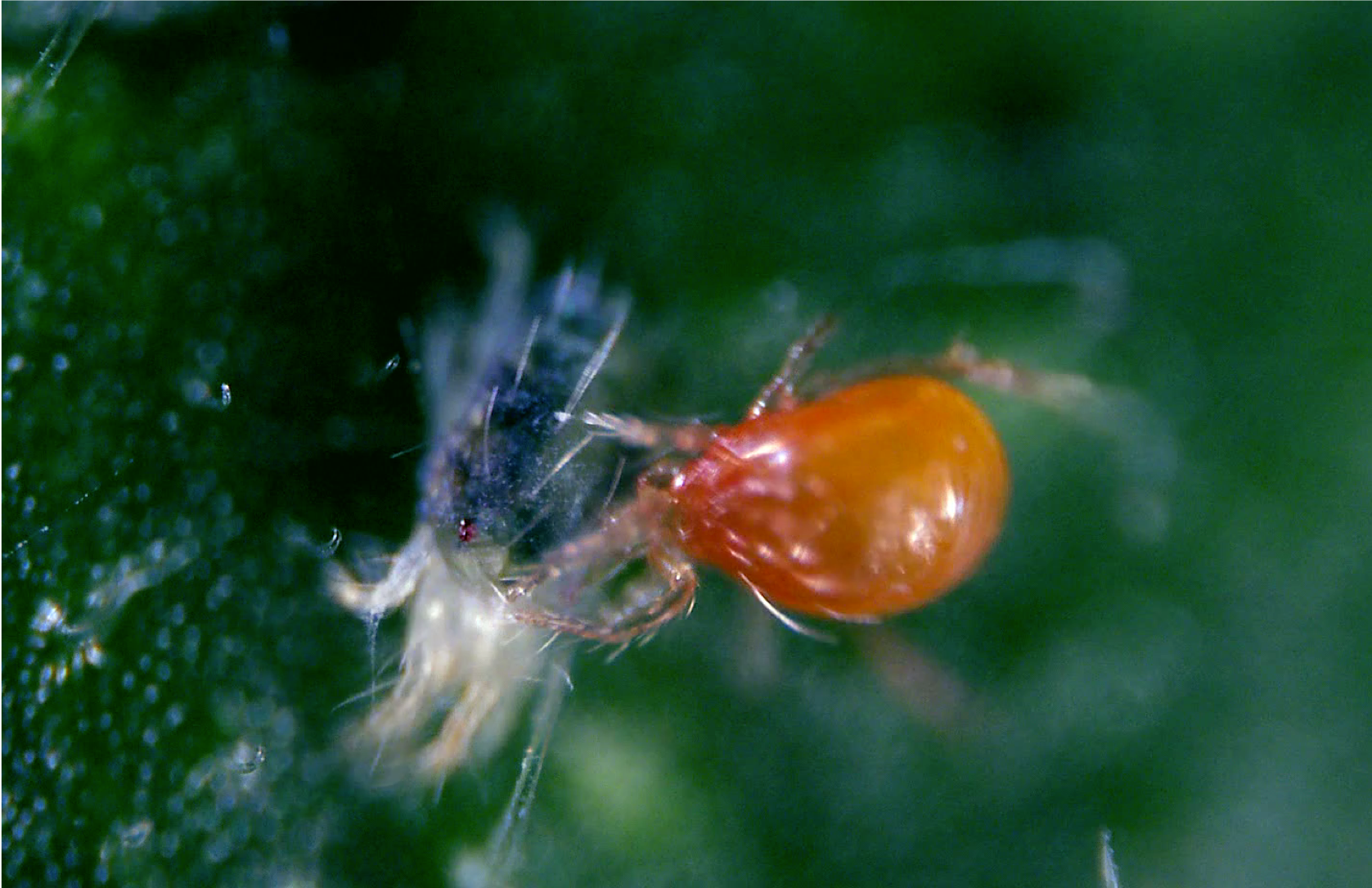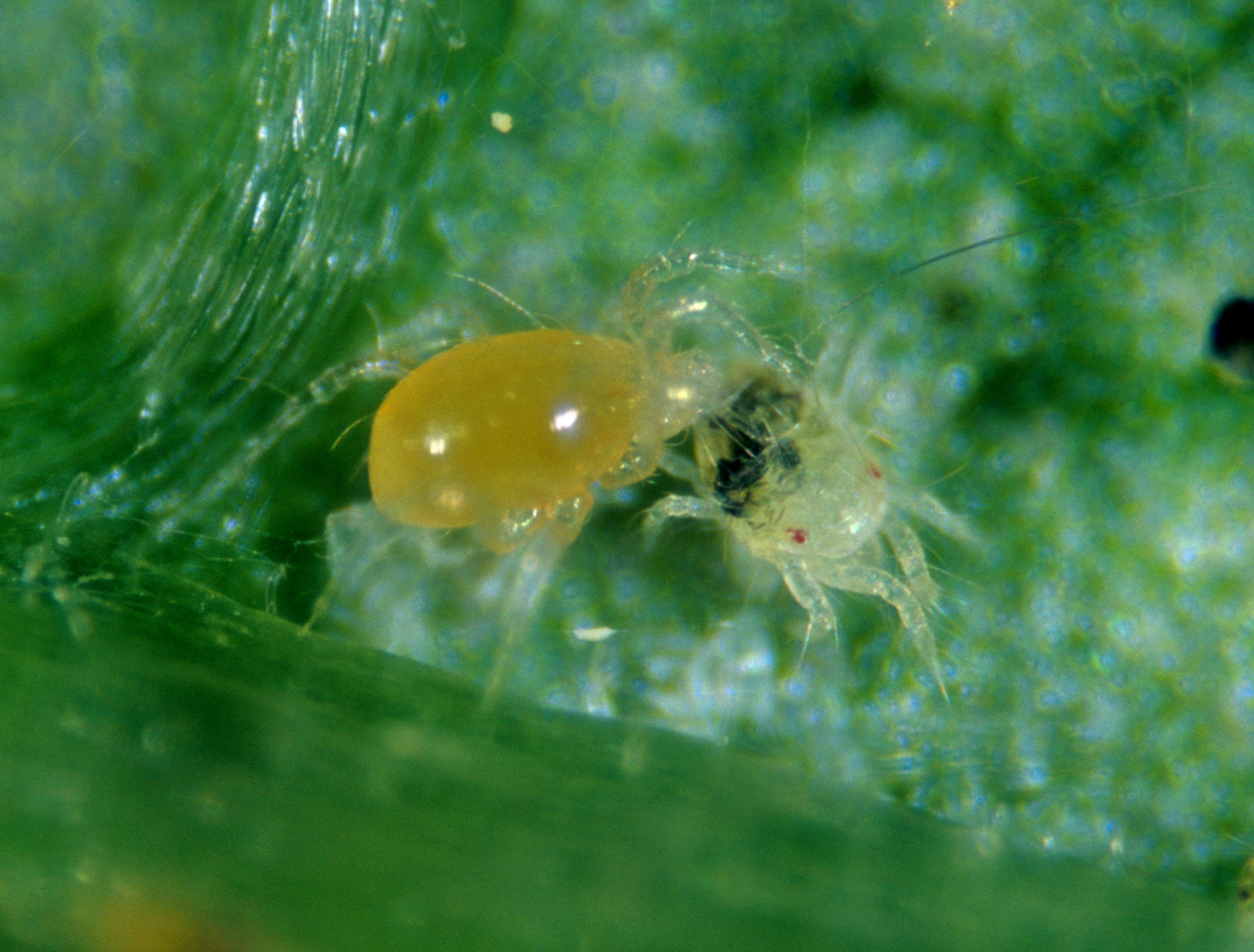
May 6, 2020
The waiting game doesn’t pay when battling two-spotted spider mites
Spider mites are common crop pests in many parts of the world, but it has taken time for rose growers to learn crucial lessons on effective biological control methods and share this knowledge. Although applying phytoseiid predatory mites to a rose crop is a viable option to get spider mite infestation under control, it does not constitute the classical biological control where predators released to feed on the prey, multiply and reduce the prey population until the two populations eventually oscillate into a balance.
What Scarab Solutions experts have learned through working closely with Kenyan rose growers for the past 15 years, is that predator reproduction in industrial greenhouse roses is low – probably due to the direct and accumulative effect of other necessary pesticides and fungicides used in the crop. Industrial rose growers should, therefore, think about predatory mites in much the same way as a biopesticide and keep applying them using the appropriate release methodology. To get this right, they need to follow a simple three-step formula.
Step one: Begin when the pest population is still low
It is essential to release predatory mites when and where spider mite population is low. Starting at a heavily pest-infested greenhouse will help neither grower, nor supplier as the reproduction of predatory mites in industrial rose greenhouses does not follow the same logic as classical biological control – predators will feed on the spider mites, but they produce comparatively few offspring.
The first step is to bring down existing spider mite population with compatible chemicals that have short-lived persistence in the crop – for instance Organo-silicone adjuvants, such as Silwet Gold, as long as they are not sprayed in direct sunlight, or other compatible chemicals recommended by the supplier. The most important outcome is that the product has a short-lived persistence – not that it kills predatory mites, which should not have been released at this stage.
Step two: Establish excellence in scouting operations and data analysis

Releasing predatory mites is a costly endeavor, so growers need to ensure they are confident in the quality of their scouting and mapping of the locations with predator deficiencies before they begin. Only spatially targeted releases of predatory mites make the effort worthwhile and help growers avoid wasting predatory mites on areas where there are no spider mites or where there are already sufficient predator numbers. Excellent scouting and data analysis tools are key here – they are at the heart of effective biological control.
Consider how scouts work. Most of their time is spent on walking diligently through the crop, searching thoroughly for the pests and diseases in each observation point, and recording their observations. But if the scout simply records presence, the only information the farm manager will glean is pest incidence – not the full understanding of the spatial distribution of the pest severity. Even if the scout records pests on a scoring scale, spends a little extra time on counting the pest in a pre-defined sampling unit and then concludes which severity score level to record, these classified scores are a far cry from the more precise statistical analysis based on count data.
Rather than having the scout spend time on deciding which score class to record, the same amount of time is much better invested in recording the real counts. There are excellent methods to master quick counting and a good scouting company can train scouts to implement them. When counts are recorded accurately, it allows the corresponding spatial analysis to map the deficiency and sufficiency of predatory mites.
Step three: Release the predators – apply targeted and blanket methods
Now growers can begin with the continuous, spatially targeted release of predatory mites in the locations with predator deficiency. Aiming these releases to bring the predator-to-spider mite ratio below 1:10 will help them get the outbreak under control rapidly. These targeted spot releases will be most effective when applying Phytoseiulus persimilis – effective predatory mites that specifically and exclusively feed on two-spotted spider mites.
Blanket releases should also be carried out by applying the resilient, more ‘generalist’ and cost-effective Neoseiulus californicus (formerly known as Amblyseius californicus) which can survive on alternative preys such as other mites and pollen. It is effective where or when the spider mite population is very low and the great hunter Phytoseiulus persimilis does not have many feeding options.
Stop wasting time – common mistakes to avoid
There are many ways cutting corners can lead to painful delays in getting to grips with spider mites. If growers release too few predatory mites – instead of just the right amount – or waste time waiting for the classical biological control dynamics to kick in, they will only extend the pain.
Another dilemma is posed by miticides and pesticides. On the one hand, when growers replace miticides with predatory mites, pests that have been previously suppressed by miticides will inevitably flare up. On the other hand, as growers turn to pesticide use against ‘new’ pest problems, these pesticides are likely to negatively affect the predatory mite population – an uncomfortable challenge in biological control.
Once the battle is won, it’s time to win the war
Treating the problem quickly and effectively requires the right number of predatory mites, rigorous control of the process and excellent monitoring and analytical tools. The good news is that once spider mite population is reduced to zero this way, growers no longer need to be so sensitive about the predatory mite population because there won’t be many of them left – they will have already done the job. Growers can treat other pest problems with peace of mind, as long as they use pesticides that have short residual effects – allowing for the application of Neoseiulus californicus if there are signs of spider mites returning.
This method will enable growers to successfully clean up spider mite-infested greenhouses one after another, applying the same strategy simultaneously in the houses that share the same workers and keep other workers away. This reduces the threat of reintroducing spider mites from one greenhouse to another. Since it is common practice across many rose farms for the same group of workers to operate in two houses, it should be simple to pair these houses and use the same strategy in both at the same time. Clean up a pair of houses and let them go into ‘maintenance mode’ with occasional blanket releases of Neoseiulus californicus, combined with continuous scouting and mapping.
Continue until all the spider mites are gone
Set up a solid work structure by identifying a biological control specialist among your personnel and make them responsible for leading the predator releases – using a combination of target releases of Phytoseiulus persimilis in hot spots and blanket releases of Neoseiulus californicus for maintenance. It is essential to continue the releases of predators until the last spider mite is gone because that is when it gets cost-effective and results begin to show in higher quality crops.
“We have benefited significantly from the improvement in the information and analysis provided by the Scarab Solutions technology,” explains John Ngugi, technical manager of Equinox Horticulture near Mt. Kenya in East Africa. “Once we had the structure and control measures in place, we reduced our requirements for Phytoseiulus persimilis by 60-90%, depending on the season.”
Learning lessons now underpins long-term success
Every farm is different, but every farm needs to develop a system to keep spider mites at bay. Excellent scouting, record-keeping and analysis is key, as it enables farm managers to evaluate the effectiveness of control measures applied – helping them learn lessons quickly, avoid wasting expensive cycles and spot potential irregularities early.
Following this three-step method will not only benefit growers through improved crop quality and lower long-term pest control costs, but also the predator supplier, who will have grown its market share in terms of hectares.

 Lisbeth Riis is founder and CEO of
Lisbeth Riis is founder and CEO of 




